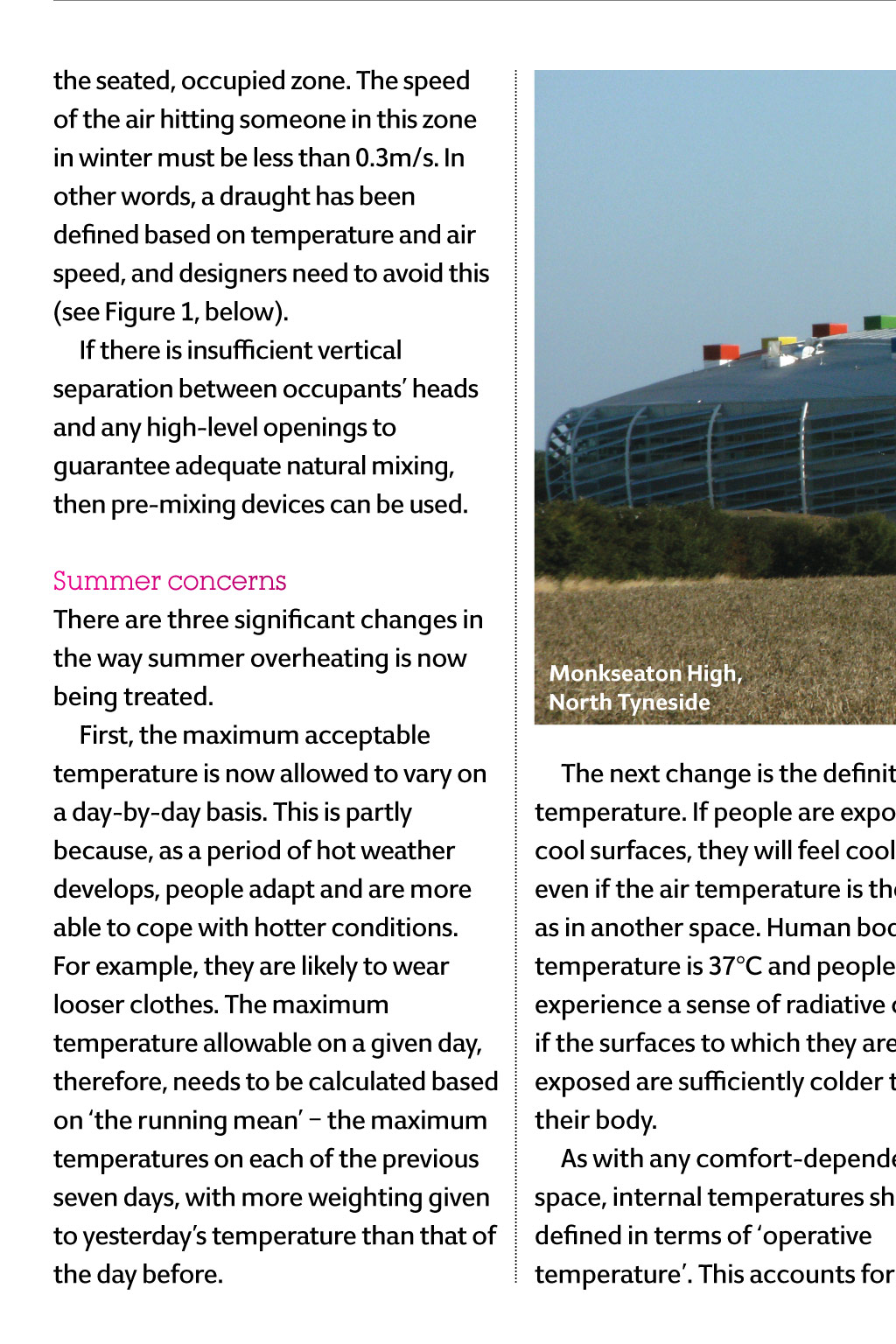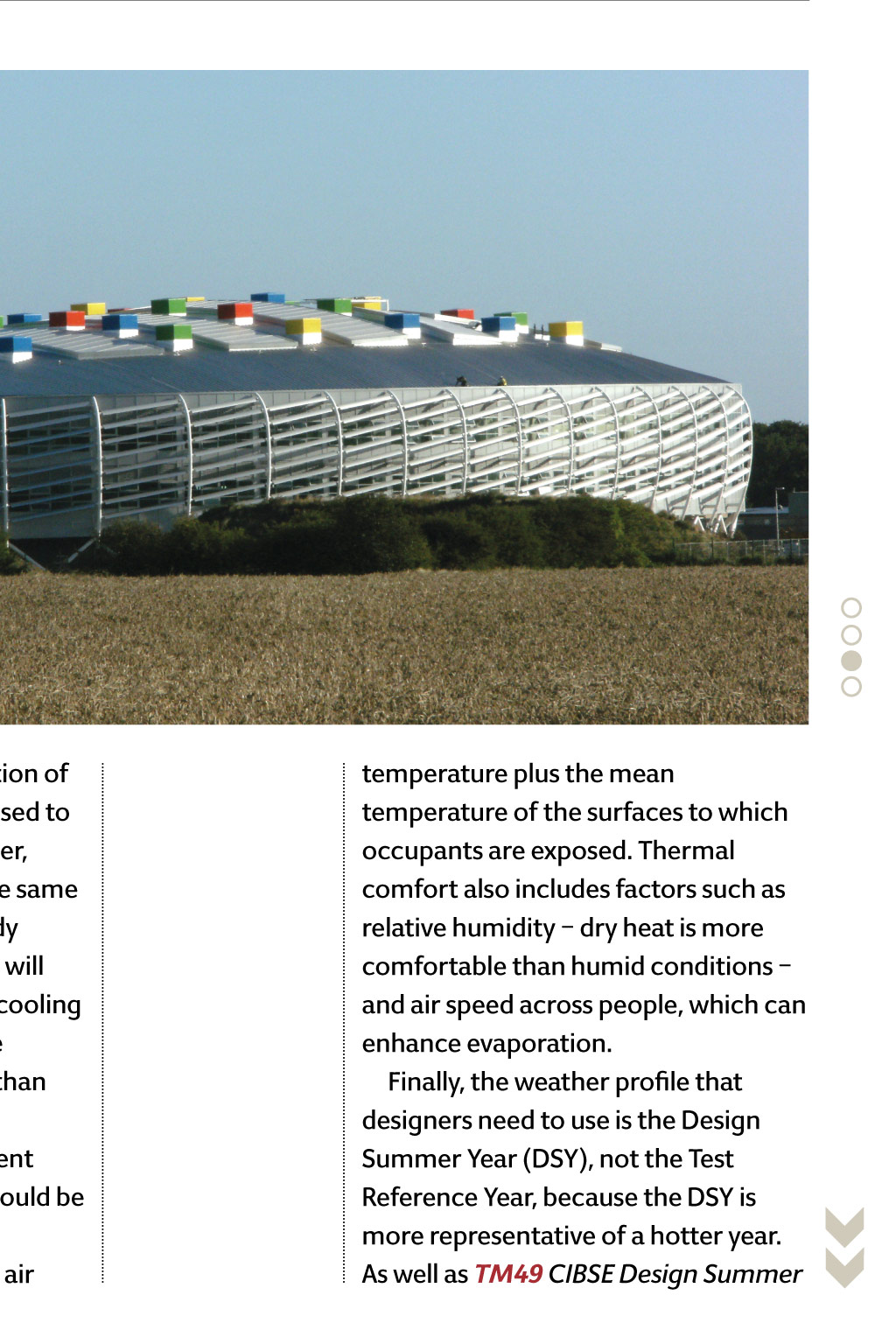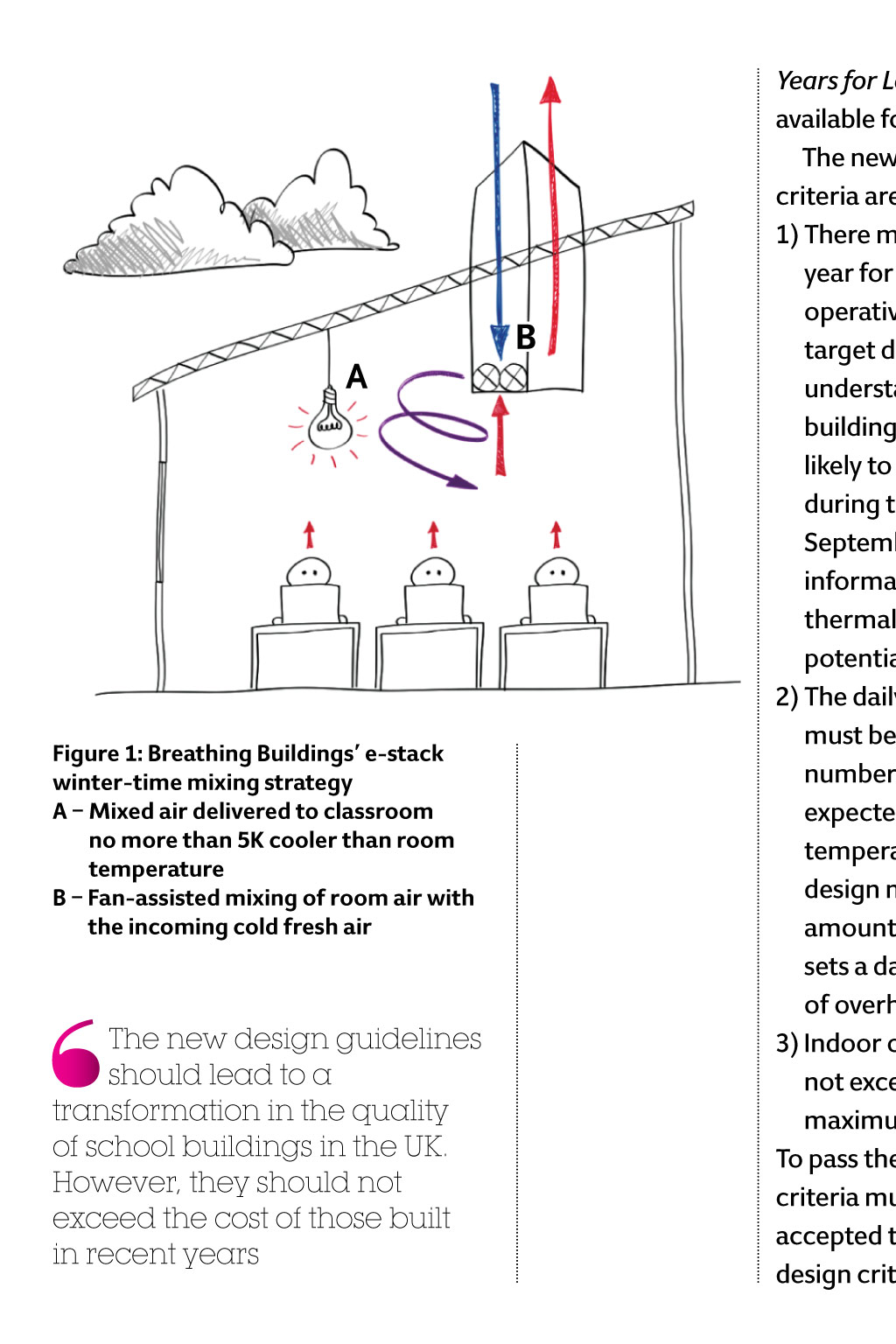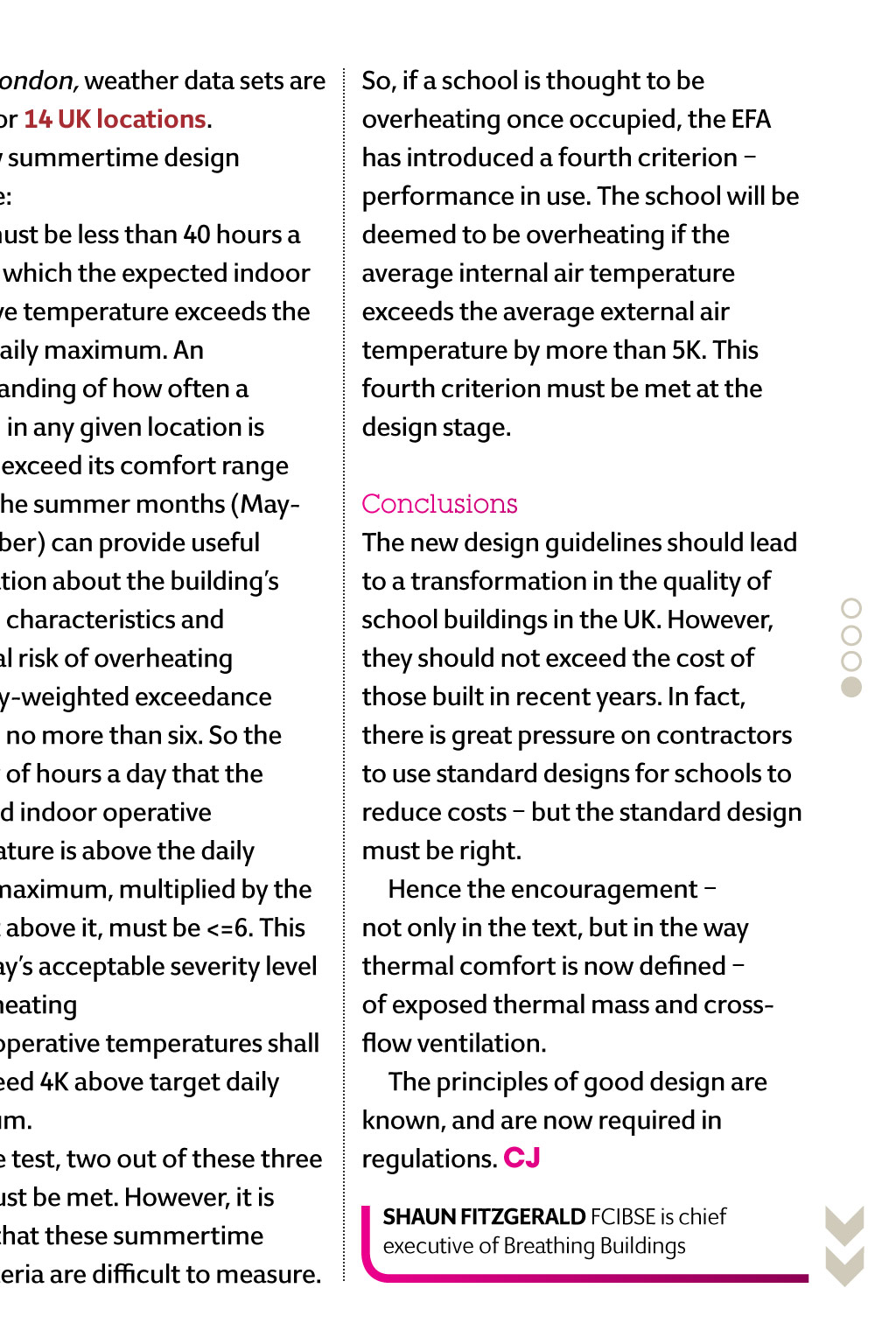
















Guidance Ventillation In Schools too Cool for school Buildings funded under the Priority Schools Building Programme have to meet new criteria for ventilation and thermal comfort to banish draughty classrooms for good. Shaun Fitzgerald explains what this means for designers t he Priority Schools Building Programme (PSBP) was set up as a funding mechanism to ensure schools in the poorest areas of the UK receive financial support for new buildings or refurbishment projects. Educational establishments funded by this programme have to meet a new set of design criteria the Facilities Output Specification (FOS). Many schools designed according to Building Bulletin 101 (BB101) suffer from various problems: some are too draughty; some have excessive heating bills; and many are deemed to overheat by occupants. The new criteria have been devised to tackle these issues, ensuring new buildings are comfortable and energy efficient. The effort expended by the Education Funding Agency (EFA) in developing the FOS was significant. However, the short timescale for putting the material together meant the document referred to in Building Regulations BB101 could not be replaced when the FOS was issued. So, for the past 18 months or so, two documents have been in circulation. Schools funded by PSBP need to meet both BB101 and the FOS; those not funded by the programme only need to meet BB101. Later this year, new guidelines derived extensively from the FOS will be issued as a replacement for BB101, for all schools. The changes in design requirements for ventilation and thermal comfort can be split into winter and summer. Once a design deals with these extremes, it is likely that internal conditions and energy use during milder days will be fine. It needs to bechecked, but, with a good design, it shouldbe straightforward to provide a comfortable space. Winter design The drive to reduce energy consumption and the capital cost of school buildings has led, in recent years, to many designers adopting natural ventilation strategies, rather than mechanical systems. On paper, this seems sensible; the heat gains in most classrooms are sufficiently high that there is little value in a heat-recovery system. In most instances, the value is negative because the additional use of energy required to drive the fans is greater than the saving in heating energy that would have been required with a properly designed natural ventilation system. However, things have fallen down on the natural ventilation front because many of the systems installed have low-level inlet dampers and an integrated heating element to preheat air, and another high-level vent for outflow. This strategy is more costly than a mechanical ventilation system with heat recovery. Other natural ventilation systems incorporate just high-level openings. These do not use excessive amounts of heating energy to mitigate cold draughts. However, high-level inflow vents can create unpleasant cold draughts, resulting in dampers being closed, so schools are not properly ventilated. simple, but critical The regulations state that, if natural ventilation is used, incoming fresh air will have to be mixed with room air before it reaches the occupants, to avoid cold draughts in winter. The regulations even state the degree of mixing required: the incoming cold fresh air must be mixed with room air until it is within 5K of the ambient temperature in the room, by the time it gets to the lower 1.4m of the space the seated, occupied zone. The speed of the air hitting someone in this zone in winter must be less than 0.3m/s. In other words, a draught has been defined based on temperature and air speed, and designers need to avoid this (see Figure 1, below). If there is insufficient vertical separation between occupants heads and any high-level openings to guarantee adequate natural mixing, then pre-mixing devices can be used. summer concerns There are three significant changes in the way summer overheating is now being treated. First, the maximum acceptable temperature is now allowed to vary on a day-by-day basis. This is partly because, as a period of hot weather develops, people adapt and are more able to cope with hotter conditions. For example, they are likely to wear looser clothes. The maximum temperature allowable on a given day, therefore, needs to be calculated based on the running mean the maximum temperatures on each of the previous seven days, with more weighting given to yesterdays temperature than that of the day before. A Figure 1: Breathing Buildings e-stack winter-time mixing strategy a Mixed air delivered to classroom no more than 5K cooler than room temperature B Fan-assisted mixing of room air with the incoming cold fresh air The new design guidelines should lead to a transformation in the quality of school buildings in the UK. However, they should not exceed the cost of those built in recent years Monkseaton High, north Tyneside The next change is the definition of temperature. If people are exposed to cool surfaces, they will feel cooler, even if the air temperature is the same as in another space. Human body temperature is 37C and people will experience a sense of radiative cooling if the surfaces to which they are exposed are sufficiently colder than their body. As with any comfort-dependent space, internal temperatures should be defined in terms of operative temperature. This accounts for air B Years for London, weather data sets are available for 14 uK locations. The new summertime design criteria are: 1) There must be less than 40 hours a year for which the expected indoor operative temperature exceeds the target daily maximum. An understanding of how often a building in any given location is likely to exceed its comfort range during the summer months (MaySeptember) can provide useful information about the buildings thermal characteristics and potential risk of overheating 2) The daily-weighted exceedance must be no more than six. So the number of hours a day that the expected indoor operative temperature is above the daily design maximum, multiplied by the amount above it, must be <=6. This sets a days acceptable severity level of overheating 3) Indoor operative temperatures shall not exceed 4K above target daily maximum. To pass the test, two out of these three criteria must be met. However, it is accepted that these summertime design criteria are difficult to measure. temperature plus the mean temperature of the surfaces to which occupants are exposed. Thermal comfort also includes factors such as relative humidity dry heat is more comfortable than humid conditions and air speed across people, which can enhance evaporation. Finally, the weather profile that designers need to use is the Design Summer Year (DSY), not the Test Reference Year, because the DSY is more representative of a hotter year. As well as TM49 CIBSE Design Summer So, if a school is thought to be overheating once occupied, the EFA has introduced a fourth criterion performance in use. The school will be deemed to be overheating if the average internal air temperature exceeds the average external air temperature by more than 5K. This fourth criterion must be met at the design stage. Conclusions The new design guidelines should lead to a transformation in the quality of school buildings in the UK. However, they should not exceed the cost of those built in recent years. In fact, there is great pressure on contractors to use standard designs for schools to reduce costs but the standard design must be right. Hence the encouragement not only in the text, but in the way thermal comfort is now defined of exposed thermal mass and crossflow ventilation. The principles of good design are known, and are now required in regulations. cJ SHaun FITzgEraLD FCIBSE is chief executive of Breathing Buildings